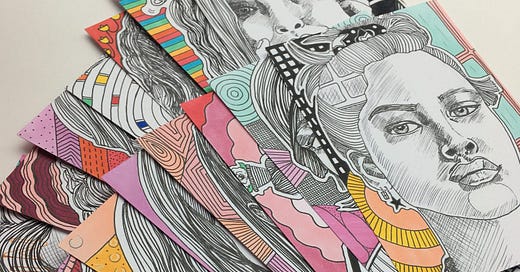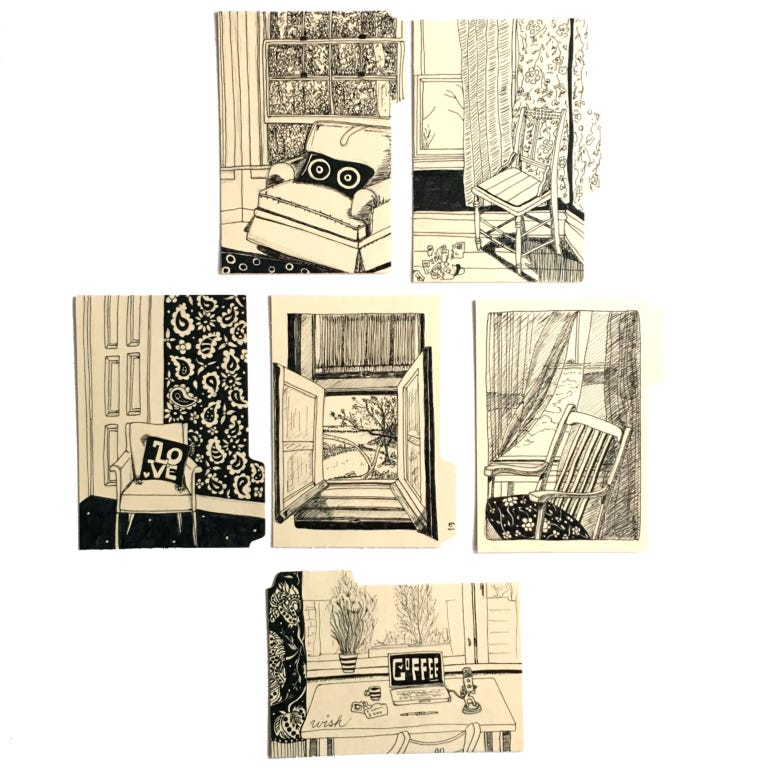Index-Card-A-Day (ICAD) 2024
Thoughts on ICAD 2024, a classic summer art challenge on index card
The Summer Index-Card-A-Day (ICAD) Challenge
Parts of this post are from a similar post last year. I am not sure I will be able to participate in ICAD for 2024, but I wanted to make sure I at least put ICAD on your radar. I’ve been supporting the ICAD challenge for a very long time, and I think it is an excellent daily summer art challenge.
🎧 To listen to this post, pull up Episode 499 of the Creativity Matters Podcast.
Ready for ICAD?
The Index-Card-a-Day (ICAD) challenge, hosted by Tammy at Daisy Yellow, starts June 1. You will find all of the official signup info, timelines, rules, and technical information on Tammy’s site.
I’ve been a long-time supporter of ICAD and have participated in this summer art challenge many, many times. Some of my favorite series have been on index cards, including a ballpoint series, a series that included chairs and windows in pen and ink, a sunglasses portrait series in Copic marker, and a second year of portraits with Copic (which I think may be my favorite year).
I encourage everyone looking for a daily challenge, or looking to nurture a creative habit, to do ICAD.

What is ICAD?
The Index-Card-a-Day Challenge (ICAD) is a 61-day art challenge in June and July. Historically, Tammy has provided weekly prompt sets to inspire daily art on a humble substrate: the index card.
The rules are simple: make something each day on an index card.
Prompts or No Prompts?
The prompts are optional, and people approach index card art in myriad ways. Some people paint. Some do collage. Some write. Some draw. There are people who doodle, people who explore gouache, and people who deep dive on a subject, like drawing noses. Really, anything goes, as long as it’s on an index card.
For some people, finding a clever approach to the prompt each day is the name of the game with ICAD. It is always inspiring to see how many different approaches people take, and the prompts are a fun way to anchor the challenge if you otherwise might not know “what” you want to create each day.
You can choose to use the prompts or not. You might also find that there are playful ways to include the prompts and still do a series of some type. (That’s been my approach.)
Index Cards?
Yes. Index cards. Index cards are a simple and accessible material and are at the heart of the ICAD challenge.
Even before ICAD, I always kept index cards stashed in my bag, and my kids always filled index cards when we sat at restaurant tables. A friend always had a wonderful habit of having any kids who dined with her draw the salt shakers. (I imagine that turned into quite a special collection over the years! I know my kids contributed several drawings to the mix.)
Index cards are simple. They are imperfect. They are easy. They are basic. They are not fancy. They don’t pretend to be something they are not.
People sometimes want to do ICAD on watercolor paper or specialty paper or in a journal or on some other surface. The spirit of ICAD, the guiding principle, has always been that the challenge is to accept and use the simple substrate and go with it. The beauty of this approach is that the material (the index card) is not “precious.”
People do amazing things on index cards!
It’s Flimsy!
A standard index card is pretty thin. It’s true. There are also thicker options.
Your cards might be lined (ruled) or plain.
The challenge is typically done with 3x5 (small) or 4x6 (large) index cards. My favorite cards are thick white ones. I also used manila tabbed ones for many, many years. They are also thick, and I loved the tabs.
Working on index cards does take some planning, and some of your ideas may not work as well on index cards as you might like. Index cards are not always great for watercolor, for instance. That doesn’t mean you can’t use watercolor, but don’t be surprised when it doesn’t behave like your favorite high-end 300 pound cotton paper.
An index card is never a perfect substrate. That is part of the charm of using index cards. They are simple. They invite exploration. They can be used for something quick or something more involved.
Rather than finding ways to work around the fact that it’s an index card, I encourage you to embrace the index card.
Try something new. Surprise yourself. Play with the prompts or with an idea you have or something you’ve wanted to explore. Let yourself enjoy the process and the rewarding feeling of making daily art and building a sustainable creative habit.
Looking Back
Some challenges really become a part of your creative landscape, and ICAD has always been that for me.
I have a “retrospective” page that helps me keep my history with ICAD in sight (and in order). I always recommend scrolling your feed or rifling through older work, in this case, older stacks of index cards.
I didn’t draw portraits when I first started doing ICAD. After I discovered my love of portraits, I did several years of portrait-focused ICAD series. One of those was a “sunglasses” series, which was a huge divergence for me because it was in color. It was also my first time using Copic markers. (Note: They didn’t really blend well on index card, but it also didn’t matter if they bled through, which is often a huge consideration when working with alcohol markers. I really enjoyed using them. They are so smooth!)
(I enjoyed the Copic marker sunglasses series so much that I printed and tried to sell postcards that year. That was silly. I ended up with lots of postcards left.)
The sunglasses portraits seem a bit sophomoric to me now, but at the time, I thought it was my best work, and it was shockingly bright and colorful for me. It was also a series I did day by day on index cards.

For a closer look at some of my ICAD series, see this video:
(Warning: This is not the greatest video ever. Apologies.)
My ICAD Tips
I tend to draw during ICAD, which is not what everyone does, but I appreciate the framework of the daily challenge, and the ICAD community has always been enthusiastic, supportive, and inspiring.
Here are a few tips from my own experience doing this challenge.
Test your idea before the start. Tammy typically does a few days of warmups before the official start. That’s a good way to get a feel for the index card surface. If you plan to work on a series (or are trying to decide about a series), I highly recommend doing a few test days to make sure you enjoy it and think you will continue to enjoy it for 61 days. (I call this “acid testing,” and I always advise this when contemplating a series.)
Be all in. If you plan to do ICAD, do ICAD. That means use index cards.
Use the size you like. I love the 4x6 size. I’ve used both, but I tend to draw larger, and I really enjoy the larger card.
Be portable. It’s been many years since we traveled in the summer, but in my early ICAD years, I was often on the road (or at my mom’s) for part of the challenge. Summer is an on-the-go time for many. You might be on vacation for part of it, or maybe you will be shepherding kids around and making art in the car or at a coffee shop. Have a portable bag that has your primary tools. One of my favorite tools that I associate with ICAD is a plastic clipboard case. It’s super convenient for keeping a pile of cards on hand and gives you a great surface for working on your card in a variety of settings. (This one looks like an updated version.)
Number and date your cards. I always intend to do this and sometimes forget as I get caught up in the daily making. It can be difficult later to sort things out, so if you like having a nice, orderly record, write the number and date on the back! (I sometimes have included the card number on the front as part of the art.)
Experiment. Don’t be afraid to try something different. That might be a medium (like marker or ballpoint), or it might be an approach (like collage) or paper sewing.
Consider a series. ICAD isn’t set up as a vehicle for series, other than that it is a sequence of 61 daily cards, but I have found it to be a beautiful and inspiring framework for a contained and focused series. (Tips for thinking about a series.)
Keep your cards organized. I used plastic boxes in the early years to hold blank and finished cards. After that, many of my years ended up in shoe boxes. Unfortunately, I think cards from the last few years may have ended up free-floating. Put them all in one place with a note about the year!
Track your ICAD. Through the years I’ve used paper trackers and electronic trackers, but I recommend tracking! It is nice to be able to look at an organized set of data about your project. It is also nice to check off each date on the way to 61!
Have fun! This is, really, the most important part. Daily art should be fun, and ICAD can be a lot of fun and a good way to spend a bit of time each day on something creative.
ICAD 2024
I don’t know yet if I will participate this year. I think I’ve at least started ICAD every year for the last many years. Last year, I started out with contours of people I saw out in the world, conceptually repeating a project I enjoyed a few years ago.
I’m always tempted to do something and play along, and I might.
I hope you consider the Index-Card-a-Day Challenge, sign up for Tammy’s newsletter to get ongoing info, look for the prompts on her Instagram feed, support her as the facilitator of a challenge you plan to do, interact with others doing ICAD, and have fun making daily art on index cards this summer.
🎪 Learn more about ICAD on the Daisy Yellow site.
Find additional resources from me, including podcast episodes, video flips, and tips for tracking a series like ICAD with Notion, see:
Episode 314 (from 2018)
I can’t wait to see what you do!
If you are participating in ICAD this year, share what plan you have (if any) in the comments below.








Acid testing is a great idea 💡 I love how ICAD has been so integral and intertwined in our creative lives ✨✨✨✨✨✨✨ thank you for “getting” the essence of the idea and for your encouragement over the years!!!
I love creative challenges, but I have never heard of this one, it such a fun idea. I love seeing your illustrations, portraits video, so thanks for sharing. Will have to circle back to read more about this and your post but just wanted to say hi! And curious what you create this summer.